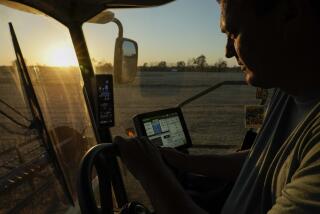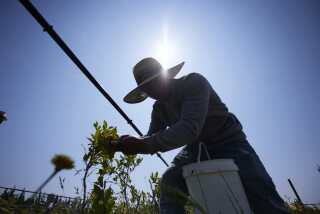Losses in Corn Sending Ripples Around World
- Share via
DeKALB, Ill. — America’s corn crop is trying to reproduce this week and the whole world is watching.
These are critical days for the country’s biggest and most important farm commodity, worth about $20 billion in a normal year. In Midwest fields that are too dry and too hot, the size of next autumn’s harvest is being determined and agronomists estimate that in areas where the drought and heat continue, farmers are losing about 5% of their harvest potential every day this week.
What happens in the next few days to the corn crop will affect meat and poultry prices because the biggest single use of corn is in animal feed. It could also affect the nation’s balance of payments. Corn is one of the country’s biggest agricultural exports and a small harvest would drive up prices and make the United States less competitive in foreign markets. However, agriculture experts do not see shortages developing if the drought lasts only a year.
Wider Repercussions
But the outcome eventually could ripple more broadly through the consumer economy. Corn is one of the most widely used agricultural commodities, found in soft drinks, automotive lubricants, shampoo, cooking oil, denim, book bindings, hair sprays, linoleum, detergents, wallpaper, inks, pet food and cosmetics.
And, as the worst drought in a half century persists, the harvest prospects are worrisome. In its first estimates of the crop year, the Agriculture Department said this week that corn production could drop by 26% in 1988. But as the growing season and the drought advance, agricultural experts believe that could become a conservative assessment.
Certainly around Illinois, one of the nation’s leading corn-growing states, the prospects are poor. State agriculture officials report half the crop is already lost.
“It looks pretty grim,” said Donald E. Meyer, the agricultural extension agent in McLean County, where Illinois’ biggest corn harvests usually take place.
“It’s like cancer,” said Bill Butler, a farmer who believes he has already lost a third to half of his 850 acres of corn. “It’s a slow death. You just keep hoping--and watching the crop slowly deteriorate.”
Mark Oehlert, a farmer, said: “I feel a very hollow feeling inside.” He estimates he may harvest only 30 to 40 bushels from land that has produced more than 150 bushels an acre. “I feel helpless.”
Indeed, there is nothing farmers can do to affect what is happening in their fields this week.
“The plant is trying to make corn, trying to perpetuate itself,” said Lyle Paul, a University of Illinois research agronomist. “It’s trying for all it’s worth.”
This year it is a real struggle for plants that have been stressed by drought almost from the time they germinated last April.
The reproductive cycle of corn, a process that resembles human reproduction, normally takes place unnoticed each year in mid-July. But this year the process is being watched by farmers, commodity brokers, grain traders and economists.
“Regardless of what your level of management skills, you’re helpless,” said Earl Williams Jr., a farmer.
To produce corn under usual conditions, the plant shoots up a pollen rich tassel from between its topmost leaves. This is the male part of the plant. About the same time the tassel appears, the cobs pop out midway up the stalk. Within a day or two, silks--hair-thin strands--begin to appear at the end of the cob. The silks, purplish and sticky, are the female part of the plant.
Each silk is attached to a little blister on the cob. For that blister to become a kernel of corn, each silk must be fertilized by pollen. The pollen falls onto the silks and moves down a little tube to the blister to begin forming a corn kernel.
All of this must happen in synchrony within a few critical days, usually in mid-July. While the plant is beginning to form corn, it requires increased water supplies, cool nights and warm but not hot days.
This year the synchrony, moisture, cool nights and warm--but not blistering--days are all missing.
“There are lots of things you can duplicate in a laboratory,” said David Whitson, DeKalb County agricultural agent, “but you can’t duplicate a drought like this one.”
In fields across the Midwest, tassels are appearing well ahead of cobs. When they do appear, cobs, which were formed weeks ago inside the cornstalk, are smaller than normal and have fewer corn blisters. Some cobs are too weak to send out silks. And those that do are sending them out well after the pollen has fallen from the tassel.
“Daddy’s up and gone before mama gets up and you never have kids that way,” said Butler, repeating a bleak joke farmers are telling among themselves.
If the lack of synchrony were not enough, extraordinary heat is burning the delicate silks and sucking the last drops of moisture out of the ground. Corn thrives in afternoon temperatures below 86 degrees. This year there have already been 23 days of 90-degree weather here in northwestern Illinois. On at least three of those days the temperature pushed over the 100-degree mark. Rainfall in this region of Illinois, like much of the state, is more than six inches below average.
“I’ve kissed my corn goodby,” said Don Engels, a farmer. “I usually grow 180 bushels an acre, year in and year out. I don’t think my best field will yield 60 bushels an acre this year.”
Oehlert said: “Something like this makes you realize how dependent we all are on nature. All of life . . . depends on the soil.”
More to Read
Sign up for Essential California
The most important California stories and recommendations in your inbox every morning.
You may occasionally receive promotional content from the Los Angeles Times.










